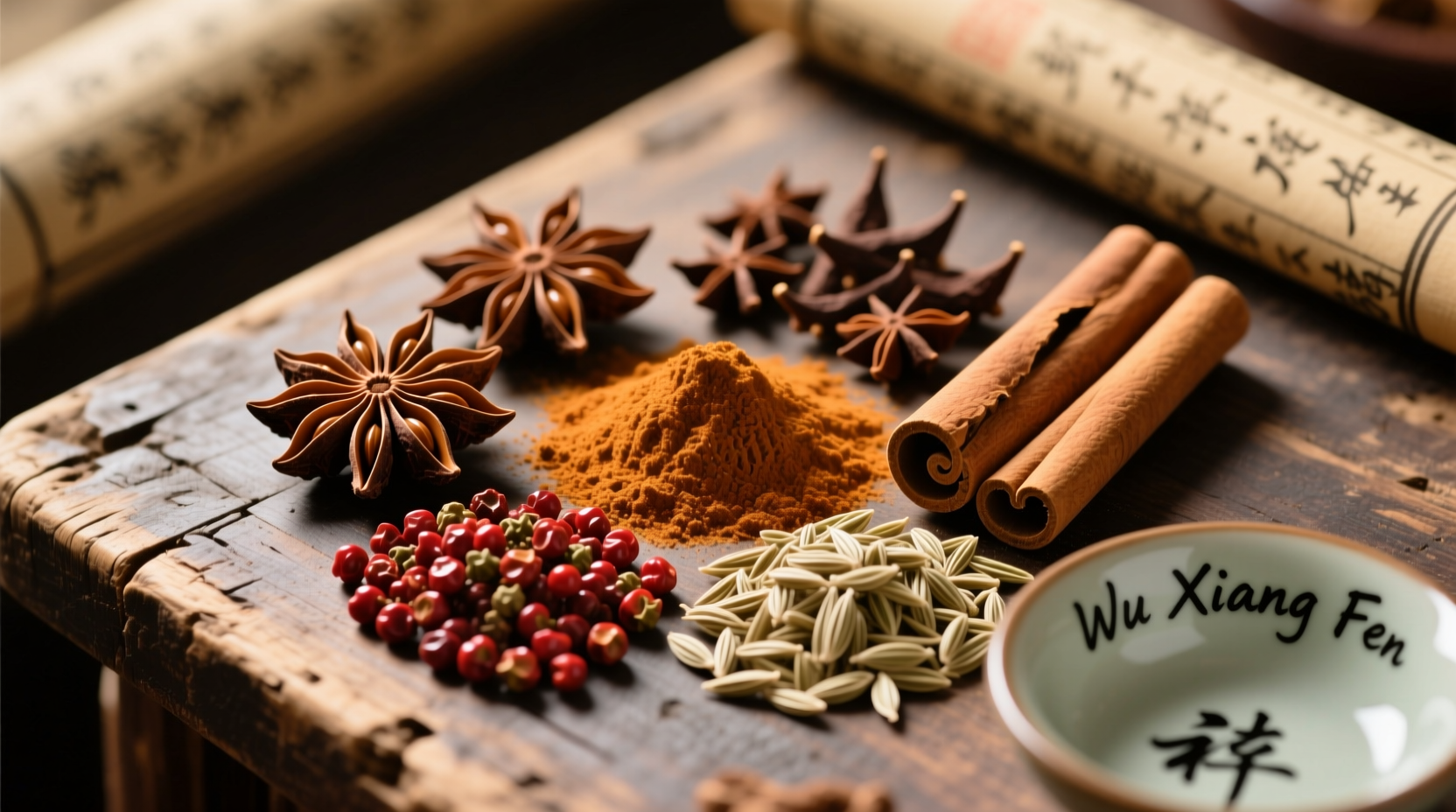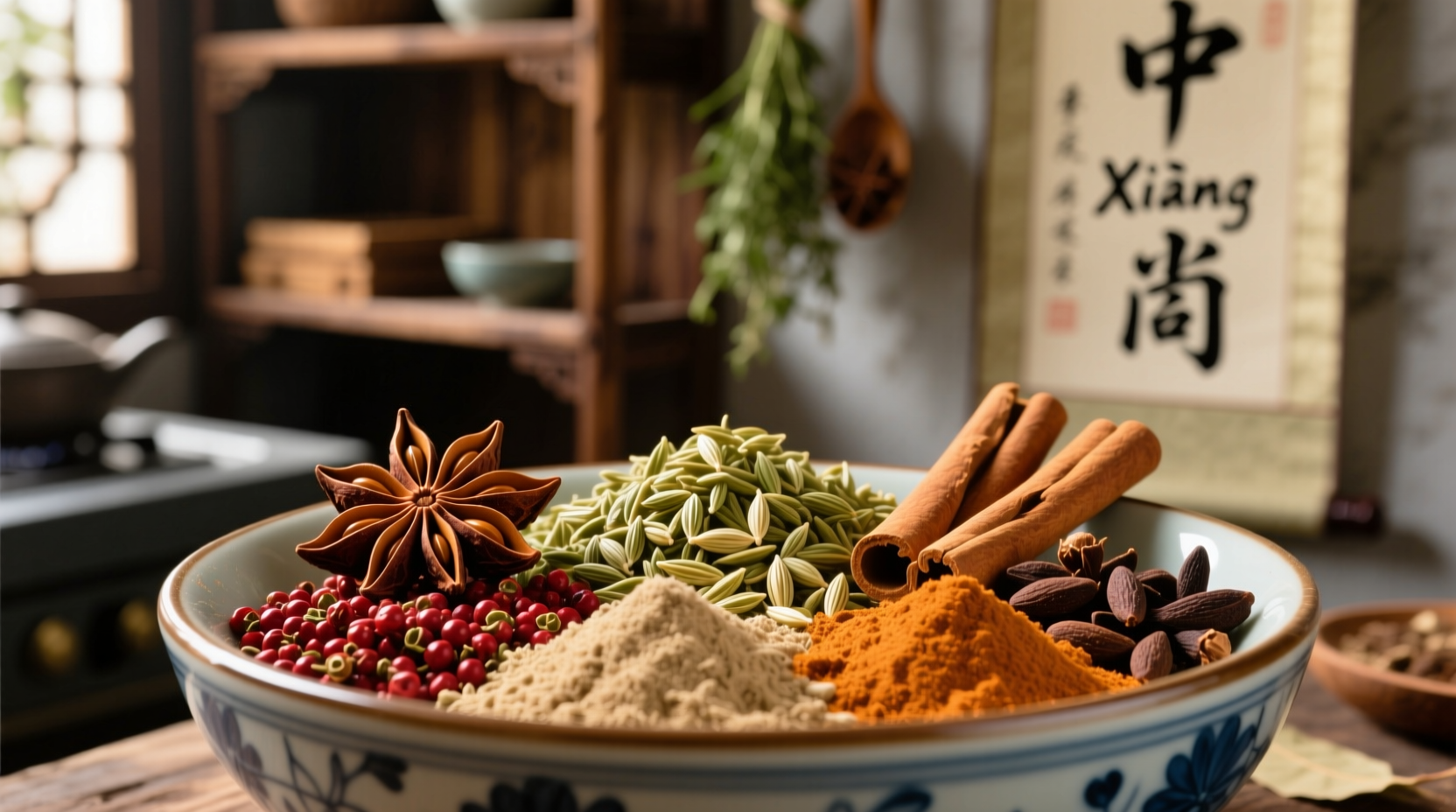Ever wondered what gives Peking duck its distinctive aroma or transforms simple roasted meats into culinary masterpieces? The secret lies in Chinese five spice powder, one of the most iconic seasoning blends in Asian cuisine. Understanding its precise composition unlocks authentic flavors in your cooking and connects you to centuries of culinary tradition.
The Essential Components of Chinese Five Spice Powder
While regional variations exist, the standard Chinese five spice powder contains these five key ingredients:
- Star anise (80% of the blend) - Provides the dominant licorice-like sweetness
- Cloves (10%) - Adds warm, pungent notes with antimicrobial properties
- Chinese cinnamon (Cinnamomum cassia, 5%) - Delivers warm, woody depth
- Sichuan peppercorns (3%) - Creates the signature mouth-tingling sensation
- Fennel seeds (2%) - Contributes subtle sweetness and earthiness

Historical Evolution of the Spice Blend
Chinese five spice powder isn't a static recipe but rather an evolving culinary tradition that reflects China's complex history of spice trade and regional preferences. The blend's development spans centuries:
| Period | Key Developments | Spice Composition Changes |
|---|---|---|
| Tang Dynasty (618-907 CE) | Early spice trading along Silk Road | Basic cinnamon and ginger combinations |
| Ming Dynasty (1368-1644) | Increased maritime spice trade | Star anise and cloves incorporated |
| Qing Dynasty (1644-1912) | Regional variations emerge | Sichuan peppercorns added in western regions |
| Modern Era | Globalization of Chinese cuisine | Standardized commercial blends developed |
According to research from the National Academies Press on traditional Chinese food systems, the five spice blend evolved as Chinese chefs sought to balance the five fundamental flavors recognized in traditional Chinese medicine: sweet, sour, bitter, salty, and umami. This philosophical approach to seasoning continues to influence how the blend is used today.
Understanding Each Spice's Role
The magic of Chinese five spice powder lies in how these ingredients work together. Let's examine each component's contribution:
Star Anise (Illicium verum)
This star-shaped fruit provides the dominant flavor in authentic blends. Unlike regular anise, star anise contains anethole, which gives it a more complex, sweeter licorice note. In traditional Chinese medicine, it's valued for digestive properties. When selecting star anise, look for deep reddish-brown pods with eight points - the number eight symbolizes prosperity in Chinese culture.
Cloves (Syzygium aromaticum)
These dried flower buds add warmth and pungency. Historically imported from Indonesia and Zanzibar, cloves contain eugenol, which has natural preservative qualities. In five spice powder, they're used sparingly as too much can overwhelm other flavors. Properly stored cloves maintain potency for up to two years.
Chinese Cinnamon (Cinnamomum cassia)
Often confused with "true" cinnamon (Ceylon cinnamon), Chinese cinnamon has a stronger, more pungent flavor with higher coumarin content. It's harvested from the bark of trees grown primarily in southern China and Vietnam. This variety provides the warm, woody backbone of the blend. When shopping, look for thick, hard quills that are reddish-brown in color.
Sichuan Peppercorns (Zanthoxylum simulans)
Despite the name, these aren't true peppercorns but the dried husks of prickly ash berries. They create the distinctive ma la (numbing-spicy) sensation essential to Sichuan cuisine. The tingling effect comes from hydroxy-alpha sanshool, which stimulates nerve endings. Authentic Sichuan peppercorns should be bright red with a floral aroma - avoid brownish varieties which indicate age and diminished potency.
Fennel Seeds (Foeniculum vulgare)
These small, aromatic seeds provide subtle sweetness and earthiness that rounds out the blend. In Chinese medicine, fennel aids digestion and balances the heating properties of other spices. When toasted properly, they release a mild anise-like flavor that complements rather than competes with the star anise.
Regional Variations Across China
Chinese five spice powder isn't monolithic - regional differences reflect local preferences and ingredient availability:
| Region | Common Variation | Best Used For |
|---|---|---|
| Cantonese (Southern China) | Standard 5-spice blend | Roasted meats, braises, marinades |
| Sichuan | Increased Sichuan peppercorns, added chili | Spicy stir-fries, mapo tofu |
| Hunan | Added dried chilies, less star anise | Smoky, fiery dishes |
| Shanghai | Slightly sweeter blend, more star anise | Sweet and sour dishes, red-cooked foods |
These regional adaptations demonstrate how Chinese five spice powder functions as a culinary framework rather than a rigid formula. As documented by the Food and Agriculture Organization of the United Nations, traditional Chinese cooking emphasizes balancing flavors according to season, region, and individual constitution - principles reflected in how the spice blend is customized.
Practical Applications in Your Kitchen
Knowing the components is just the beginning - understanding how to use Chinese five spice powder elevates your cooking:
When to Use Pre-Made vs. Homemade
Commercial blends offer convenience but often contain preservatives and may have stale spices. For best results:
- Use store-bought for quick weeknight meals or when you need consistent results
- Make your own when cooking special dishes where freshness matters most
Proper Storage Techniques
Spices lose potency quickly when exposed to light, heat, and air. To maximize shelf life:
- Store in airtight containers away from heat sources
- Keep whole spices until ready to use (ground spices lose flavor 3x faster)
- Grind small batches as needed using a dedicated coffee grinder
- Store in the freezer for long-term preservation (up to 2 years)
Culinary Applications
Chinese five spice powder shines in these applications:
- Meat rubs - Especially effective on pork belly, duck, and chicken
- Braising liquids - Adds depth to soy-based sauces
- Marinades - Combine with soy sauce, rice wine, and honey
- Vegetable seasoning - Toss with root vegetables before roasting
- Stock enhancements - Add to bone broths for complexity
Common Mistakes to Avoid
Even experienced cooks make these errors with Chinese five spice powder:
- Using too much (start with 1/4 teaspoon per pound of meat)
- Adding it too late in cooking (add early to allow flavors to meld)
- Using it with strongly flavored ingredients that overwhelm it
- Not toasting whole spices before grinding (releases essential oils)
- Storing near the stove (heat degrades flavor compounds)
Creating Authentic Homemade Blend
For the freshest flavor, make your own Chinese five spice powder:
Basic Recipe (Yields 1/4 cup)
- 2 tablespoons star anise (whole)
- 1 teaspoon whole cloves
- 1 cinnamon stick (about 3 inches)
- 1 teaspoon Sichuan peppercorns
- 1 teaspoon fennel seeds
Instructions
- Toast whole spices in a dry skillet over medium-low heat for 2-3 minutes until fragrant
- Cool completely (about 15 minutes)
- Grind in spice grinder until fine powder forms
- Sift through fine mesh strainer to remove larger particles
- Store in airtight container away from light and heat
This homemade version will stay fresh for up to 6 months when stored properly. For Cantonese-style dishes, maintain the standard ratio. For Sichuan-style cooking, increase Sichuan peppercorns to 2 teaspoons and add 1/2 teaspoon dried chili flakes.











 浙公网安备
33010002000092号
浙公网安备
33010002000092号 浙B2-20120091-4
浙B2-20120091-4